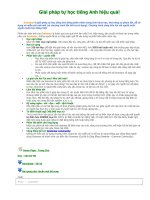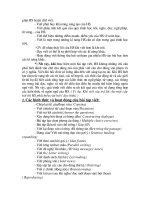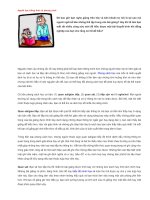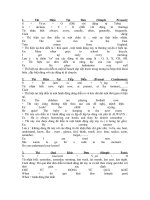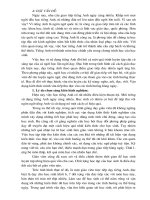học tiếng Pháp cơ bản bằng tiếng Anh
Bạn đang xem bản rút gọn của tài liệu. Xem và tải ngay bản đầy đủ của tài liệu tại đây (1.14 MB, 244 trang )
Beginning
French
for the Utterly
Confused
A. Sebastián Mercado
McGraw-Hill
New York Chicago San Francisco Lisbon London Madrid
Mexico City Milan New Delhi San Juan Seoul Singapore
Sydney Toronto
Mercado_2p_fm.j.qxd 4/15/03 8:28 AM Page iii
Copyright © 2003 by The McGraw-Hill Companies, Inc. All rights reserved. Manufactured in the
United States of America. Except as permitted under the United States Copyright Act of 1976, no part
of this publication may be reproduced or distributed in any form or by any means, or stored in a data-
base or retrieval system, without the prior written permission of the publisher.
0-07-142591-8
The material in this eBook also appears in the print version of this title: 0-07-140811-8
All trademarks are trademarks of their respective owners. Rather than put a trademark symbol after
every occurrence of a trademarked name, we use names in an editorial fashion only, and to the benefit
of the trademark owner, with no intention of infringement of the trademark. Where such designations
appear in this book, they have been printed with initial caps.
McGraw-Hill eBooks are available at special quantity discounts to use as premiums and sales pro-
motions, or for use in corporate training programs. For more information, please contact George
Hoare, Special Sales, at or (212) 904-4069.
TERMS OF USE
This is a copyrighted work and The McGraw-Hill Companies, Inc. (“McGraw-Hill”) and its licensors
reserve all rights in and to the work. Use of this work is subject to these terms. Except as permitted
under the Copyright Act of 1976 and the right to store and retrieve one copy of the work, you may not
decompile, disassemble, reverse engineer, reproduce, modify, create derivative works based upon,
transmit, distribute, disseminate, sell, publish or sublicense the work or any part of it without
McGraw-Hill’s prior consent. You may use the work for your own noncommercial and personal use;
any other use of the work is strictly prohibited. Your right to use the work may be terminated if you
fail to comply with these terms.
THE WORK IS PROVIDED “AS IS”. McGRAW-HILL AND ITS LICENSORS MAKE NO GUAR-
ANTEES OR WARRANTIES AS TO THE ACCURACY, ADEQUACY OR COMPLETENESS OF
OR RESULTS TO BE OBTAINED FROM USING THE WORK, INCLUDING ANY INFORMA-
TION THAT CAN BE ACCESSED THROUGH THE WORK VIA HYPERLINK OR OTHERWISE,
AND EXPRESSLY DISCLAIM ANY WARRANTY, EXPRESS OR IMPLIED, INCLUDING BUT
NOT LIMITED TO IMPLIED WARRANTIES OF MERCHANTABILITY OR FITNESS FOR A
PARTICULAR PURPOSE. McGraw-Hill and its licensors do not warrant or guarantee that the func-
tions contained in the work will meet your requirements or that its operation will be uninterrupted or
error free. Neither McGraw-Hill nor its licensors shall be liable to you or anyone else for any inac-
curacy, error or omission, regardless of cause, in the work or for any damages resulting therefrom.
McGraw-Hill has no responsibility for the content of any information accessed through the work.
Under no circumstances shall McGraw-Hill and/or its licensors be liable for any indirect, incidental,
special, punitive, consequential or similar damages that result from the use of or inability to use the
work, even if any of them has been advised of the possibility of such damages. This limitation of lia-
bility shall apply to any claim or cause whatsoever whether such claim or cause arises in contract, tort
or otherwise.
DOI: 10.1036/0071425918
ebook_copyright 8 x 10.qxd 7/7/03 5:11 PM Page 1
This book is dedicated to the memory of my father.
Mercado_2p_fm.j.qxd 4/15/03 8:28 AM Page v
I
would like to thank my friend Jean Yates for being the first one who
helped me make this book a reality and Grace Freedson for putting me
in contact with the people of McGraw-Hill. I would also like to thank
my friend and colleague Charles Fernández-Pérez for reading the manu-
script. His suggestions were highly appreciated. They helped me make this
book a better product. In addition, I would like to thank another friend and
colleague, Carole Lauzière, for her comments and suggestions. Finally, I
would like to thank Ligia Ochoa and Juan Manuel Millares for helping me
with some minor but important details.
vvv
vii
vvvvvvvvvvvvvvvvvvvvvvvv
vvvvvvvvvvvvvvvvvvvvvvvvvv
Acknowledgments
Mercado_2p_fm.j.qxd 4/15/03 8:28 AM Page vii
Contents ix
Preface xv
Guide for the User xvii
Guide to Pronunciation xix
Chapter 1 A
`
l’école de langues 1
Do I need to read this chapter? 1
Dialogue 1.1 2
Get Started 2
Subject Pronouns 5
Regional Variations 5
Verbs 6
The French Alphabet 7
Dialogue 1.2 7
Useful Vocabulary 8
Verbs 11
Question Words 14
Expressing Quantity: Numbers 0–69 15
Expressing one’s age 15
Giving your address 16
Test Yourself 17
Answer Key 19
vvv
ix
vvvvvvvvvvvvvvvvvvvvvvvv
Table of Contents
vvvvvvvvvvvvvvvvvvvvvvvvvv
Mercado_2p_fm.j.qxd 4/15/03 8:28 AM Page ix
For more information about this title, click here.
Copyright © 2003 by The McGraw-Hill Companies, Inc. Click here for Terms of Use.
x
Contents
Chapter 2 La nouvelle collègue 21
Do I need to read this chapter? 21
Dialogue 2.1 22
Get Started 23
Expressing Quantity: Numbers after 70 26
Giving the date 27
Introducing people 27
Saying good-bye 27
New verbs 28
Prepositions à and chez 29
Regular plurals with -s 30
Yes/no questions 30
Dialogue 2.2 30
Useful Vocabulary 31
New verbs 32
Asking who someone is 35
Negation with ne pas 36
Stressed pronouns 36
Test Yourself 38
Answer Key 39
Chapter 3 Les vacances de Maxime 41
Do I need to read this chapter? 41
Dialogue 3.1 42
Get Started: Useful Vocabulary 43
Verbs 44
Expressing likes and dislikes 47
Family members 48
Expressing possession: Possessive adjectives 49
Demonstrative adjectives 50
Dialogue 3.2 51
Useful Vocabulary 52
Making polite requests 53
pas de (negation with avoir)54
Dialogue 3.3 54
Useful Vocabulary 55
Information questions: qu’est-ce que c’est and qui est-ce ? 56
Test Yourself 57
Answer Key 59
Mercado_2p_fm.j.qxd 4/15/03 8:28 AM Page x
Contents
xi
Chapter 4 Vive le carnaval! 61
Do I need to read this chapter? 61
Dialogue 4.1 62
Get Started 63
To buy and to pay 64
Vocabulary: Means of transport 66
Clock time 67
Il y a 68
Ordinal numbers 69
Currencies in French-speaking countries 69
Dialogue 4.2 70
Useful Vocabulary 71
Forming questions: Inversion of verb and subject 72
Pourquoi ? . . . Parce que . . . 74
Expressing daily routines with reflexive verbs 74
Test Yourself 80
Answer Key 84
Chapter 5 L’entrevue de Vincent 85
Do I need to read this chapter? 85
Dialogue 5.1 86
Get Started 87
Expressing past events: le passé composé (1) 88
Dialogue 5.2 90
Useful Vocabulary 91
Expressing past events: le passé composé (2) 91
Adverbs 94
Prepositions with place names 95
Preposition pour 98
Dialogue 5.3 98
Useful Vocabulary 99
The passé composé of pronominal verbs 100
Past participles used as adjectives with être 101
Test Yourself 103
Answer key 105
Mercado_2p_fm.j.qxd 4/15/03 8:28 AM Page xi
xii
Contents
Chapter 6 Deux fêtes et un mal de tête 107
Do I need to read this chapter? 107
Dialogue 6.1 108
Get Started 109
Expressing recently passed events 110
Expressing future events 111
Locating events in time or temporal expressions 112
Dialogue 6.2 113
Useful Vocabulary 113
Expressing actions that are happening at the
moment of speaking and simultaneously 115
Giving orders: The imperative 116
Parts of the body 120
Talking about health 121
Dialogue 6.3 121
Useful Vocabulary 122
Giving Directions: Useful Expressions 122
Test Yourself 123
Answer Key 125
Chapter 7 J’ai perdu un livre ! 127
Do I need to read this chapter? 127
Dialogue 7.1 128
Get Started 129
Direct object pronouns 130
Expressing possession (2) 133
Colors 133
Dialogue 7.2 134
Useful Vocabulary 134
Indirect object pronouns 135
Test Yourself 138
Answer Key 140
Chapter 8 Il était une fois . . . 141
Do I need to read this chapter? 141
Dialogue 8.1 142
Get Started 142
Mercado_2p_fm.j.qxd 4/15/03 8:28 AM Page xii
Contents
xiii
L’imparfait (the imperfect) 144
Using on as an equivalent to “you” in English 146
A letter to Carole 147
Useful Vocabulary 148
Expressing past events with the passé composé
and the imperfect 149
Writing informal letters 149
Test Yourself 150
Answer Key 152
Chapter 9 Qu’est-ce qu’on mange aujourd’hui ? 153
Do I need to read this chapter? 153
Dialogue 9.1 154
Get Started 155
Demonstrative pronouns with ci and là 156
Demonstrative adjectives (2) 157
ne . . . personne 157
Dialogue 9.2 158
Useful Vocabulary 160
The partitive article 161
ne . . . plus 162
Dialogue 9.3 163
Useful Vocabulary 164
ne rien 165
ne . . . jamais 165
Test Yourself 166
Answer Key 168
Chapter 10 Rira bien qui rira le dernier 171
Do I need to read this chapter? 171
Reading 10.1 172
Get Started 173
Expressing future events: The simple future 176
Different ways of expressing future events 178
Irregular plurals for some nouns 179
Plural forms for adjectives 180
Adjectives that precede a noun 180
Mercado_2p_fm.j.qxd 4/15/03 8:28 AM Page xiii
xiv
Contents
Dialogue 10.1 181
Useful Vocabulary 182
Hypothesizing with si (1) 182
Making suggestions 183
Test Yourself 184
Answer Key 186
Chapter 11 Une québécoise à Paris 187
Do I need to read this chapter? 187
Dialogue 11.1 188
Get Started 189
The present conditional 190
Forms and functions of tout 192
Dialogue 11.2 193
Useful Vocabulary 194
Hypothesizing with si (2) 196
The pronoun y 197
Test Yourself 200
Answer Key 203
Chapter 12 Une réunion entre amis 205
Do I need to read this chapter? 205
Dialogue 12.1 206
Get Started 207
Expressing wishes and feelings: The present subjunctive 207
Dialogue 12.2 211
Useful Vocabulary 213
The pronoun en 214
Test Yourself 217
Answer Key 220
Index 221
Mercado_2p_fm.j.qxd 4/15/03 8:28 AM Page xiv
T
he main objective of Beginning French for the Utterly Confused is to
present the basic concepts of the French language in a clear, easy-to-use
format. It is designed to help beginning students of French attain an
intermediate level of oral and written proficiency and enable them to under-
stand and be understood in a reasonably short period of time. It begins with
a pronunciation guide, then goes on to explain in simple terms, and in a cul-
tural context, the rules of grammar, usage, and mechanics of French. High
school and university students, as well as business professionals and adults
in general, will learn to speak and write in a correct and competent manner.
This practical course of 12 chapters provides simple, clear explanations
based on a functional approach. It is designed both to facilitate steady and
rapid progress as well as to make language learning enjoyable. Each lesson
contains a number of instructional paragraphs which are illustrated by
model sentences and supported by exercises (with answers) and word lists.
Conversational dialogues and idiomatic language appear in every lesson. A
Test Yourself section developed to help students build confidence and
acquire important concepts of the language appears at the end of each chap-
ter.
Finally, this is not a travel phrase book. It has clear and complete gram-
mar explanations. Phrases and vocabulary are introduced with real language
in context using conversations and readings. It is the sincere desire of the
author that this book will help students improve their knowledge of the
French language.
vvv
xv
vvvvvvvvvvvvvvvvvvvvvvvv
Preface
vvvvvvvvvvvvvvvvvvvvvvvvvv
Mercado_2p_fm.j.qxd 4/15/03 8:28 AM Page xv
Copyright © 2003 by The McGraw-Hill Companies, Inc. Click here for Terms of Use.
T
he following steps are recommended to help you obtain the maximum
benefits from this book.
1. Read the Guide to Pronunciation at the beginning of the book.
2. Before starting a chapter, read over the communication skills as well as
the grammar and vocabulary skills that will be taught in that lesson.
Decide whether to read it or skip it if you think you are already proficient
in those skills.
3. Once you have decided to study a chapter, start by reading the dialogue
or text in French. Then, study the “Useful Vocabulary” section and read
the dialogue or text again.You can invert this order and start by examin-
ing the “Useful Vocabulary” section first and then reading the dialogue or
text. Since repetition and practice may lead to automatization of speech,
you can read the dialogues aloud, repeat them several times, or perhaps
even memorize them.
4. In case there is something you think you have missed, you can read the
translation of the dialogue or text. The translation provided is not word
for word, but an approximation of how it would sound in a real conversa-
tion in English.
5. After reading the text or dialogue and studying the vocabulary, read the
simplified grammar explanations provided.
6. Repeat steps 3, 4, and 5 every time you find a dialogue or reading activity
in a chapter.
7. At the end of the chapter, do the Test Yourself exercises and check your
answers provided in the Answer Key.
vvv
xvii
vvvvvvvvvvvvvvvvvvvvvvvv
Guide for the User
vvvvvvvvvvvvvvvvvvvvvvvvvv
Mercado_2p_fm.j.qxd 4/15/03 8:28 AM Page xvii
Copyright © 2003 by The McGraw-Hill Companies, Inc. Click here for Terms of Use.
F
or every line of dialogue you will find the approximate pronunciation with
symbols in italics. These symbols are not part of the International Phonetic
Alphabet andonly serve asa guideand support.We hopethat these symbols
make your pronunciation come as close as possible to native speech. We have
tried to simplify the pronunciation for you.Due to the fact that French has many
sounds thatdo not existin English,wehad to adaptthe pronunciation withletters
and symbolsthat insome casescoincide withEnglish,butnot always.Forthat rea-
son, we suggest you take a few minutes to observe the explanations of each one
of thosesymbols and an“approximate pronunciation.”In thoseexplanations you
will find hints on how to place your mouth and lips to make the sound.
Vowels
French officially has 16 vowel sounds.English has about 12.In order to simplify
the pronunciation, we have combined some vocalic sounds which are so simi-
lar that in some French-speaking regions no difference is made.
vvvvvvvvvvvvvvvvvvvvvvvv
Guide to Pronunciation
vvvvvvvvvvvvvvvvvvvvvvvvvv
vvv
xix
Approximate Possible written Example
Symbol pronunciation forms pronunciation
i like the ee in i, y si
see si
é closed e, similar é, es, er, ai été
to a in late, but été
a pure vowel not a
diphthong
è open e, similar to è, ê, ais, ai, est père
bed pèr
Mercado_2p_fm.j.qxd 4/15/03 8:28 AM Page xix
Copyright © 2003 by The McGraw-Hill Companies, Inc. Click here for Terms of Use.
xx
Guide to Pronunciation
Approximate Possible written Example
Symbol pronunciation forms pronunciation
a open a (but not a, à patte
as open as a in pat
cat)
â closed a, â, a (usually pâte
similar to short before s) pât
a in car
ò open o, similar to o école
pore ékòl
o closed o, similar o, ô, au, eau hôtel
to o in no (but a otèl
pure vowel not a
diphthong)
u short u, like in ou nous
too nu
ü pronounce ee as u tu
in see, but round tü
your lips as if you
were going to say
oo
ö like ur in fur, eu feu
but shorter fö
ë like er in her, eu, œu sœur
but round your lips sër
e called neutral e e leçon
or “schwa”; like a lesõ
in ago
ã nasal a; let the an, am, en, em temps
air flow out of your tã
nose
˜e nasal e; let the in, ain, aim, ym, pain
air flow out of your un*, um* p˜e
nose
õ nasal o; let the on, om chanson
air flow out of your shãsõ
nose
Note: In order to make it simpler for the learner, we have placed the written form un/um with
˜e. There is a slight difference in pronunciation: un or um are pronounced like ˜e but with
rounder lips, just like a nasal ë. However, this distinction is not made in all French-speaking
regions of the world. Since in some areas un and um are pronounced like ˜e, we have chosen
this symbol for these written forms.
Mercado_2p_fm.j.qxd 4/15/03 8:28 AM Page xx
Guide to Pronunciation
xxi
Semivowels
Semivowels are never pronounced alone. They are always accompanied by another
vowel. They are weaker and shorter than a vowel, but are pronounced in the same
area of the mouth. Semivowel w is like a very short u; semivowel y is like a very short
i; and semivowel ÿ is like a shorter ü.
Possible
Approximate written Example
Symbol pronunciation forms pronunciation
wwas in water oi, oin, oui, ouer, roi
ouez rwa
y similar to the y in ail, aille, eil, eille, hier
yet ille, euille, ouille, yèr
ya, io, ier, ié, ui,
uet
ÿ like a shorter ü ui, uet lui
lÿi
Consonants
There are 17 consonant sounds in French.They are quite similar to English. In most
cases, their pronunciation does not change depending on their position in the word,
unlike English consonant sounds.
Possible
Approximate written Example
Symbol pronunciation forms pronunciation
b like b in boy b bateau
bato
d like d in day d dire
dir
g like g in goat g ( + a, o, u) guerre
gu ( + e, i) gèr
p like p in put p porte
pòrt
Mercado_2p_fm.j.qxd 4/15/03 8:28 AM Page xxi
xxii
Guide to Pronunciation
Possible
Approximate written Example
Symbol pronunciation forms pronunciation
t like t in top t tendre
tãdr
k like k in kilo k, c ( + a, o, u) quand
qu kã
m like m in my m mère
mèr
f like f in fast f, ph photo
foto
s like s in sand s (beginning of poisson
word) pwasõ
ss (between vowels)
t (in —tion endings)
sh like sh in ship ch château
shato
ñ similar to ny in gn agneau
Kenya año
l soft l similar to l il
let il
r guttural: rolled in r reine
the throat rèn
n like n in no n non
nõ
v like v in veal v vélo
vélo
z like z in zoo z (any position) oiseau
s (between vowels) wazo
zh like s in j, g ( + e, i) gérant
pleasure zhérã
Mercado_2p_fm.j.qxd 4/15/03 8:28 AM Page xxii
Guide to Pronunciation
xxiii
Stress
French words are always stressed on the final, pronounced syllable. For this reason,
whenever you see a word of more than one syllable, stress the last syllable that you
see in italics (in the pronunciation guide for each word). In the following examples,
the stressed syllable has been underlined
for you.
Example Pronunciation translation
université ünivèrsité university
chanson shãsõ
song
boulevard bulvar
boulevard
françaises frãsèz
French women
French word-groups are also stressed on the final syllable. This could be more diffi-
cult for foreign learners. In cases where two or more words are definitely pro-
nounced as one unit, it will appear as one word in italics. We have underlined
the
stressed syllable again. Observe the following examples:
Example Pronunciation translation
mon école mõnékòl my school
(je) m’appelle mapèl
my name is
s’il vous plaît silvuplè
please
Silent letters
Some letters are silent depending on their position in the word. We have listed the
most frequent cases below.
• The letter h
The letter h is silent except when it is combined with c and p. When it is combined
with any of those letters, the sound of that other letter is modified.
ch = pronounced sh
ph = pronounced f
• The final -e and the neutral e or “schwa.”
Usually, the final written -e is not pronounced, except when there is an accent as in -é.
Example Pronunciation translation
facile facil easy
employée ãplwayé employee (fem.)
allemande almãd German (fem.)
Note that when masculine nouns and adjectives form their feminine by adding an
-e, this last letter is not pronounced (see employée). If the preceding letter is a con-
sonant, it must be pronounced (see allemande).
Mercado_2p_fm.j.qxd 4/15/03 8:28 AM Page xxiii
xxiv
Guide to Pronunciation
Sometimes, the neutral e (or schwa) is not pronounced when it appears in the center
of a word. In those cases, it is usually optional to pronounce it or not.To make it eas-
ier for learners, we have deleted that e from the pronunciation when natives do not
usually pronounce it. Observe the e in the word allemand in the examples above.
• Double consonants
If a word has double consonants, the consonant sound is only pronounced once in
most French-speaking areas.
Example Pronunciation translation
attention atãsyõ attention
elle èl she
poisson pwasõ fish
• Final consonants
Final consonants are usually not pronounced, but there are exceptions. However,
exceptions have been carefully indicated in the pronunciation part of the chapters.
Example Pronunciation translation
tabac taba tobacco
petit peti little (masc.)
parc park park
Liaison
This is something very typical of the French language, although it is not exclusive to it.
A word that ends in a nonpronounced consonant may acquire the final sound of that
consonant before another word beginning with a vowel or silent h. The consonant
sound is pronounced as part of the second word. Observe the following examples:
Example Pronunciation translation
les écoles lè zékòl the schools
quand on kã tõ when we
mon ami mõ nami my friend (m.)
Written accents
There are three possible written accents in French.They appear on vowels, never on
consonants. Observe the following table with the names and forms of those accents:
Name of the accent Letter it appears on
accent aigü é
accent grave à, è
accent circonflexe â, ê; î, ô, û
Mercado_2p_fm.j.qxd 4/15/03 8:28 AM Page xxiv
Guide to Pronunciation
xxv
In some cases, the pronunciation of the letter changes and, therefore, it becomes a
different sound. In other cases, the accent has a diacritic function.That means that it
distinguishes between two different words that are written the same.
é closes the vowel
è opens the vowel
ê opens the vowel (identical to è)
â closes the vowel
à only appears on preposition à to distinguish it from a (avoir)
ô closes the vowel
î diacritic
û diacritic
Dieresis
The dieresis (ë, ï) is used to break a diphthong so that every letter is pronounced. For
example, in the word Noël the two vowels are pronounced separately. ë is pro-
nounced /è/. The word mais is pronounced /mè/ and the word maïs is pronounced
/mais/. The same happens with Haïti. The name of the country is pronounced /haiti/.
Mercado_2p_fm.j.qxd 4/15/03 8:28 AM Page xxv
Beginning
French
for the Utterly
Confused
Mercado_2p_fm.j.qxd 4/15/03 8:28 AM Page xxvii
You should read this chapter if you need to review or learn about:
Communication skills
➜
Asking or giving personal information (name, address, job, studies, age,
nationality)
➜
Greeting formally
➜
When to use informal tu or formal vous
➜
Counting from 0 to 69
➜
Spelling
Grammar and vocabulary skills
➜
Definite articles
➜
Personal pronouns
➜
The present tense of the verbs être and avoir and regular -er ending verbs
➜
Feminine form of some nouns or adjectives
➜
Using questions words comment and quel/quelle
T
h
i
s
C
h
a
p
t
e
r
?
t
o
R
e
a
d
D
o
I
N
e
e
d
vvv
1
vvvvvvvvvvvvvvvvvvvvvvvv
vvvvvvvvvvvvvvvvvvvvvvvvvv
CHAPTER 1
À l’école de langues
Mercado_2p_01.j.qxd 4/15/03 8:30 AM Page 1
Copyright © 2003 by The McGraw-Hill Companies, Inc. Click here for Terms of Use.
2
BEGINNING FRENCH FOR THE UTTERLY CONFUSED
Dialogue 1.1
Montpellier, France. Julian Walters, an American student, arrives at l’École de Langues
Vivantes in Montpellier. He wants to register for a French course. Read the conversation
carefully.
Montpellier, France. Julian Walters, un étudiant américain, arrive à l’École de Langues
Vivantes de Montpellier. Il veut s’inscrire dans un cours de français comme langue étrangère.
Lisez attentivement la conversation.
JULIAN Bonjour, madame.
bõzhur madam.
LA SECRÉTAIRE Bonjour. Vous êtes nouveau à notr école ?
bõzhur. vu zèt nuvo a notr ékòl ?
JULIAN Oui, madame. C’est mon premier jour.
wi, madam. sè mõ premyé zhur.
LA SECRÉTAIRE D’accord. Comment vous vous appelez ?
dakòr. komã vu vu zaplé ?
JULIAN Je m’appelle Julian Walters.
zhe mapel Julian Walters.
LA SECRÉTAIRE Vous pouvez épeler votre nom, s’il vous plaît ?
vu puvé éplé vòtr nõ silvuplè ?
JULIAN Bien sûr. J-U-L-I-A-N-W-A-L-T-E-R-S.
by˜e sür. zhi-ü-èl-i-a-èn-dublevé-a-èl-té-èr-ès.
Translation
JULIAN Good morning.
SECRETARY Good morning. Are you new at this school?
JULIAN Yes, I am. It’s my first day.
SECRETARY OK. What’s your name?
JULIAN My name’s Julian Walters.
SECRETARY Could you spell your name, please?
JULIAN Certainly. It’s J-U-L-I-A-N-W-A-L-T-E-R-S.
Get Started
The following vocabulary will be useful throughout this chapter.
Mercado_2p_01.j.qxd 4/15/03 8:30 AM Page 2
À l’école de langues
3
Nouns
madame madam madam, Mrs.
monsieur mesyö sir, Mr.
mademoiselle madmwazèl Miss
l’étudiant (m.) létüdyã the student (male)
l’étudiante (f.) létüdyãt the student (female)
le jour (m.) le zhur the day
l’école (f.) lékòl the school
la fiche d’inscription la fish d˜eskripsyõ the registration form
le nom (m.) le nõ the name
votre nom vòtr nõ your name
Definite articles
In most of the examples above, a definite article precedes the noun (le, la, l’, or les). The use
of the definite article in French is similar to its use in English. One of its main uses is to
accompany nouns that are already known from the context. In English, there is only one def-
inite article, the, for singular and plural. In French, the choice of the article depends not only
on number but also on gender. Masculine nouns use le; feminine nouns use la; le, and la are
shortened to l’ if they immediately precede a noun beginning with a vowel or a silent h. All
plural nouns, whether masculine or feminine, use les (pronounced lè). Table 1-1 summarizes
these rules.
Definite English
article equivalent Examples
Masculine le/l’ the le jour/l’étudiant
Feminine la/l’ the la rue/l’école
Plural les the les jours/les écoles
TABLE 1-1 Definite articles
Adjectives
nouveau (m.) nuvo new
nouvelle (f.) nuvèl new
Mercado_2p_01.j.qxd 4/15/03 8:30 AM Page 3
4
BEGINNING FRENCH FOR THE UTTERLY CONFUSED
Other words or expressions
à l’école de langues a lékòl de lãg at the language school
oui wi yes
non nõ no
d’accord dakòr OK, all right
bien sûr by˜esür certainly
merci mèrsi thank you
s’il vous plaît silvuplè please
Formal greetings
bonjour bõzhur good morning
bonsoir bõswar good evening
bonne nuit bòn nÿi good night
Comment ça va ? kòmã sa va ? How are you?
Très bien, merci. trè by˜e mèrsi Fine, thank you.
Quick Tips
1. If English uses a definite article, use one in French. It will work in most
cases.
2. Remember to use l’ if the article immediately precedes a noun beginning with
a vowel or a silent h.
3. If the plural article les immediately precedes a noun or adjective beginning
with a vowel or silent h, the -s in les must be pronounced. However, it will be
pronounced like a z and as if it were part of the noun/adjective and not part
of the article. This is called liaison. For example:
les écoles → le zékòl
4. There is also an h aspiré (aspirate) in French. This name could be misleading
because this h is not pronounced either. Rather, words beginning with this
written h need the full article le or la and no liaison should be made. Don’t
worry, there are not that many words that begin with the h aspiré, and we will
point them out when necessary.
Mercado_2p_01.j.qxd 4/15/03 8:30 AM Page 4

